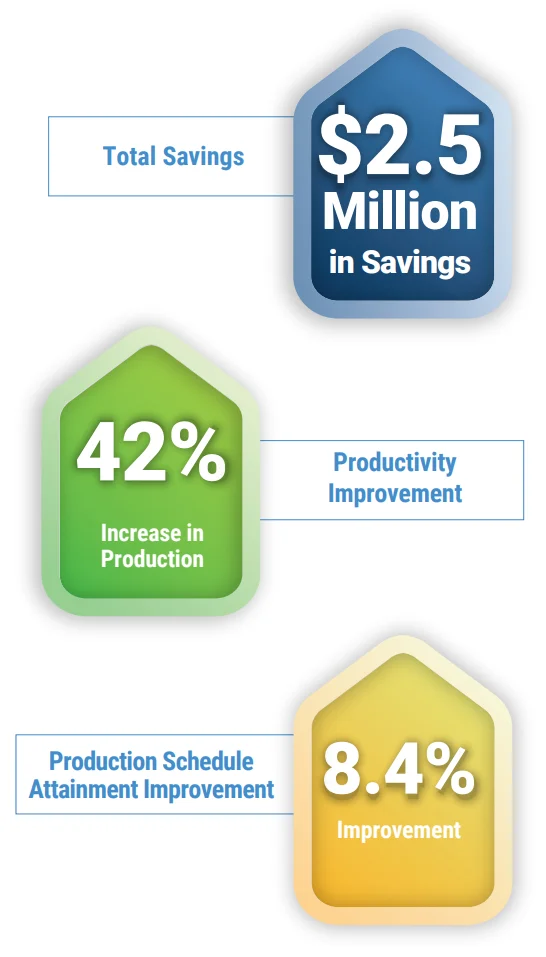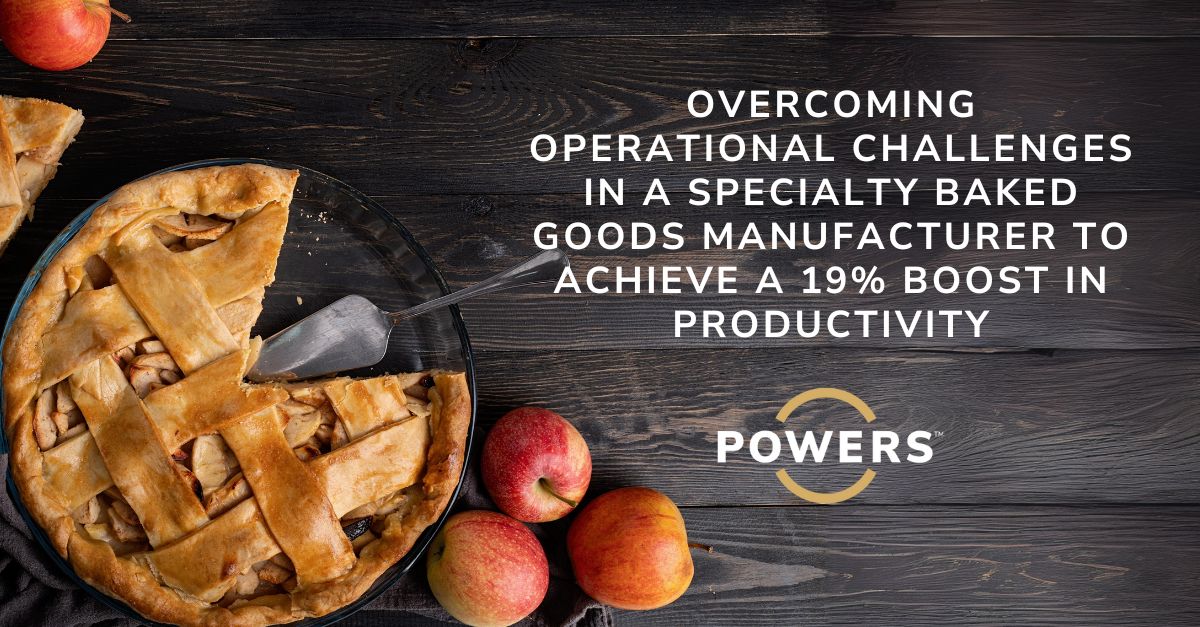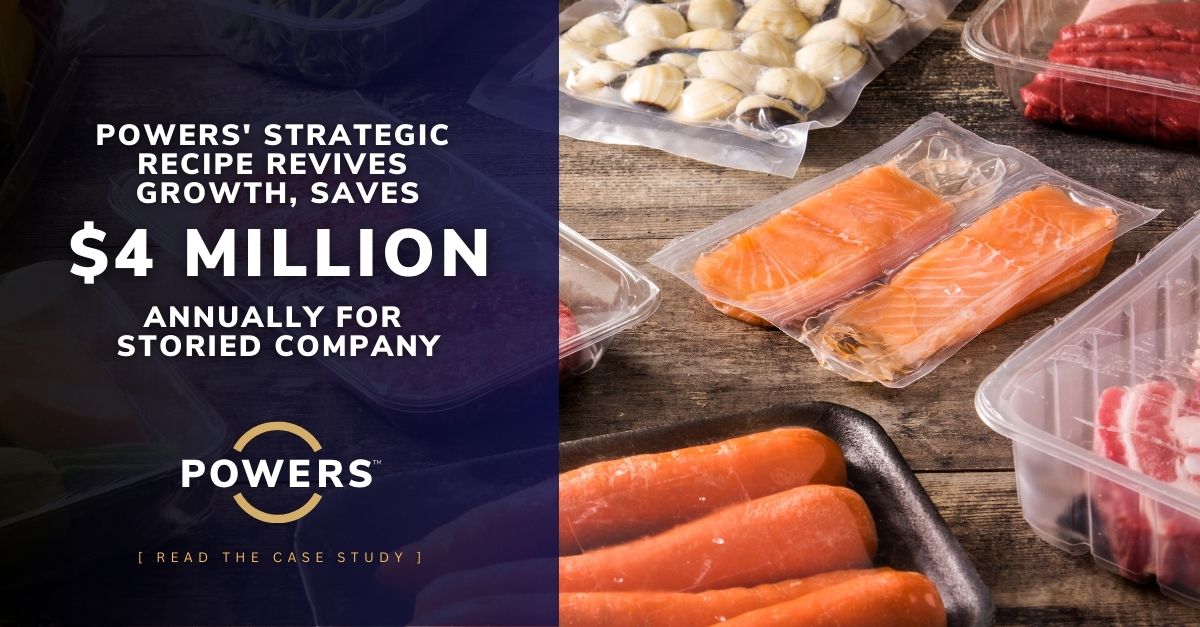

Project Overview

Performance Results
Situation
A prominent player in the frozen food sector, deeply rooted in familial culinary traditions, faced operational hurdles within its Production and Maintenance Management Operating System (MOS). The absence of standardization and outdated MOS elements perpetuated a reactive culture, hampering decision-making and leading to constant states of stressful “firefighting.” Supervisory efficacy waned, and despite data abundance, root cause analysis lagged. Operational issues persisted, impacting performance and profitability.
In need of a strategic shift, the frozen food giant sought to identify areas for improvement and develop a comprehensive transformation plan. Through detailed assessment and analysis, POWERS identified operational inefficiencies and developed a transformation plan.
This case study unravels POWERS’ transformative intervention to reinvigorate operations. Detailed Analysis of Challenges Faced Before POWERS’ Intervention.
Analysis
The frozen food distribution company, operating within a competitive landscape, grappled with a multitude of operational challenges before POWERS’ transformative intervention. The issues outlined in the scenario provide insights into the intricate hurdles this company confronted:
- Lack of Standardization and Outdated MOS Elements: The Production and Maintenance Management Operating System (MOS) lacked a standardized approach, riddled with outdated elements that impeded efficiency. This absence of uniform processes created inconsistencies in operations, leading to suboptimal performance.

- Reactive "Firefighting" Culture and Persistent Operational Issues: The prevailing culture within the organization favored reactive responses rather than proactive management. This mindset hindered the ability to address operational issues at their root, perpetuating a cycle of solving immediate symptoms without tackling underlying problems.
- Inadequate Floor Controls and Supervision: Supervisors faced challenges in maintaining effective floor controls, lacking tools and systems to enable proactive supervision and variance management. This deficiency limited their ability to foresee and address issues in real time, negatively impacting overall production efficiency.
- Underutilization of Data for Root Cause Analysis: Although the company gathered substantial amounts of data, the analysis and utilization of this data were lacking. The inability to extract actionable insights from data hindered the identification and elimination of root causes underlying operational challenges.
- End-to-End Production Flow Disruptions: The company's end-to-end production flow suffered from visible and concealed waste, equipment downtime, defects, high scrap rates, rework, and improper staffing. This constellation of issues led to a cycle of substandard performance.
- Material Usage Variance (MUV) Challenges: The company faced significant challenges in managing Material Usage Variance (MUV), with the MUV significantly exceeding the budget. This resulted in substantial financial losses amounting to over $1.5 million per month.
- Suboptimal Schedule Attainment: The company struggled to attain its production schedule goals, with a base performance of 84% against a targeted goal of 90%. This shortfall in schedule attainment impacted the company's ability to meet market demands efficiently.
- Low Productivity Levels: Productivity levels were alarmingly low, tracking at a base of only 256 pieces per labor hour. This indicated inefficiencies in resource allocation, process flow, and overall production management.
In essence, the frozen food distributor grappled with a myriad of challenges that encompassed operational inconsistencies, reactive management practices, data underutilization, persistent issues, and significant financial losses due to MUV, among others. The production process experienced disruptions, translating into low productivity, suboptimal schedule attainment, and an overall atmosphere of inefficiency. These challenges collectively hindered the company's growth, competitiveness, and ability to provide high-quality products to its customers. It was within this complex environment that POWERS' intervention aimed to catalyze transformative change.
The Plan
POWERS designed a comprehensive strategy to bring about positive changes in the production and maintenance management system. The plan centered around three key domains: Maintenance, Production, and Sanitation. Each domain was targeted to address specific challenges and foster collaboration between functions.
Elevating Maintenance
- Preventative Maintenance Optimization: A preventative maintenance (PM) system was designed to ensure that equipment was properly maintained and running at optimal efficiency. The PM system also helped identify potential issues before they became larger problems.
- Increase Technician Utilization: Optimize technician utilization to improve maintenance efficiency. This included improving technology and scheduling techniques.
- Improve Equipment Reliability: Enhance equipment reliability to reduce downtime and defects.
- Establish Better Communication: Foster improved communication between functions for cohesive operations.
Boosting Production
- Increase 1st Pass Quality Yield: Focus on improving product quality at the first pass to reduce defects.
- Labor Optimization: Utilize observations, line balancing, and resource loading for efficient labor allocation.
- Waste Reduction: Implement root cause analysis to drive preventive actions for waste reduction.
- Proactive Supervision: Enhance proactive supervisory actions to boost productivity.
- Communication Enhancement: Improve inter-departmental communication for seamless operations.
Refining Sanitation
- Sanitation Operations Optimization: Optimize sanitation processes for efficient production startup.
- Eliminate Production Startup Impacts: Minimize disruptions during production startup.
- Prevent Water Intrusion Damage: Implement measures to prevent repeat water intrusion damage.
- Enhance Communication: Foster better communication between sanitation and other functions.
The alignment of these multi-dimensional efforts, interwoven with clear communication strategies and meticulous problem-solving methodologies, set the stage for substantial positive change across the organization. As the strategy unfolded it enhanced the organization's operational capabilities and reaffirmed its dedication to excellence, efficiency, and long-term expansion.
The Solution:
The collaborative efforts between the frozen food giant and POWERS led to a transformative solution that tackled key challenges, resulting in substantial improvements across critical performance indicators. Each facet of the solution addressed specific problems, ushering in a new era of efficiency, effectiveness, and cost savings.
- Material Usage Variance (MUV) Improvement: The company was grappling with a Material Usage Variance (MUV) that led to substantial financial losses. This discrepancy stemmed from inefficiencies in material usage and waste management, impacting the company's bottom line. By implementing focused root cause analysis and preventive
actions, the company successfully reduced the MUV from $(1.4M) to $(373k), marking an impressive 73% improvement in just three months. This solution rectified the wastage issue, enhancing cost control and ensuring better utilization of resources. - Production Schedule Attainment Improvement: The company struggled to achieve its production schedule attainment target, with performance at 84%, falling short of the 90% goal. This inefficiency led to delays, missed targets, and production disruptions. Through the implementation of various production optimization strategies, the company's production schedule attainment rose from 84% to 91%, surpassing the initial goal by an 8.4% margin. This enhancement improved overall production efficiency, reduced delays, and ensured smoother production cycles.
- Productivity Enhancement: Facing low productivity, with an initial measurement of 256 pieces per labor hour Powers identified inefficiencies in labor allocation, task execution, and overall process optimization. With a focus on labor optimization, line balancing, and
proactive supervision, Powers empowered the company to witness a remarkable turnaround in productivity. The average productivity surged to an impressive 363 pieces per labor hour, showcasing a substantial 41.8% improvement. This solution streamlined the workforce, maximized output, and enhanced overall operational efficiency. - Savings Realization: This frozen food distributor aimed to achieve significant cost savings but was struggling to meet its target of $2.18M in savings. This shortfall could be attributed to operational inefficiencies, wastage, and suboptimal resource utilization.
Through the meticulous execution of the multifaceted solution, the company achieved exceptional savings of $2.53M, surpassing the target by 16%. This remarkable 116% savings over the 30-week engagement translated to enhanced financial stability, enabling the company to reinvest the surplus funds into critical growth initiatives. Through a strategic partnership with POWERS, this industry-leading player successfully transformed its production and maintenance management system. By addressing challenges, enhancing communication, fostering proactive management, and implementing preventive measures, the company achieved substantial improvements across various performance indicators. The collaboration not only led to immediate savings but also laid the foundation for sustained growth, operational excellence, and enhanced competitiveness in the dynamic frozen
food industry





